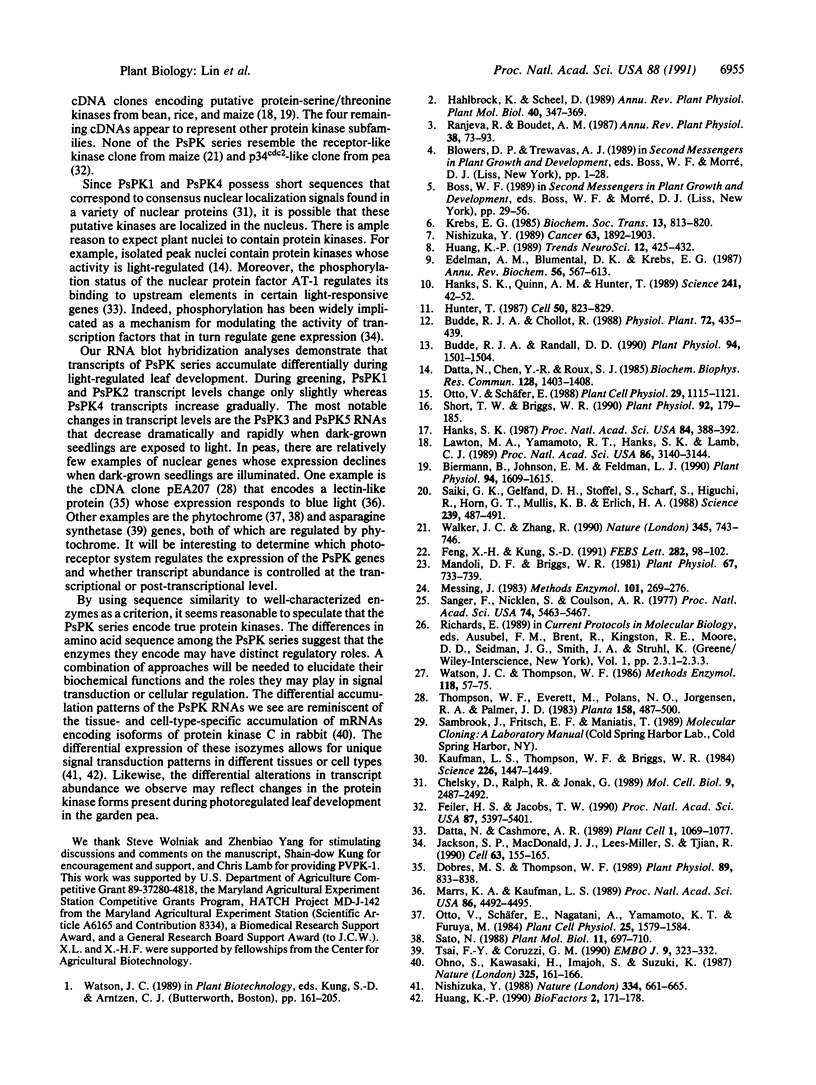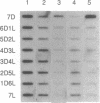Abstract
Degenerate oligonucleotides, corresponding to conserved regions within the catalytic domain of known protein-serine/threonine kinases, were used as primers for the polymerase chain reaction to amplify cDNA synthesized from poly(A)+ RNA purified from the apical buds of 7-day-old pea seedlings. Five partial cDNAs were obtained and designated PsPK1 through PsPK5 (for Pisum sativum protein kinase) in order of decreasing length. The deduced amino acid sequences show that each member of the PsPK series is different in length, and, although their sequences are quite similar overall, each has a unique sequence. Moreover, each member of the PsPK series has structural features typical of members of the protein-serine/threonine kinase family of protein kinases. All are equally similar to cyclic nucleotide-dependent protein kinase and protein kinase C, suggesting that the pea homologs may be involved in signal transduction. DNA gel blots show that each PsPK cDNA is likely to be encoded by a single gene within the pea genome. RNA blot analyses show that the PsPK transcripts accumulate differentially during greening of etiolated seedlings. PsPK3 and PsPK5 transcripts show a large and rapid decline during deetiolation. In contrast, the level of PsPK4 RNA increases steadily during deetiolation whereas PsPK1 and PsPK2 transcripts show little change during the greening period. Thus light regulates changes in the levels of transcripts encoding putative protein kinases in plants.
Full text
PDF




Images in this article
Selected References
These references are in PubMed. This may not be the complete list of references from this article.
- Biermann B., Johnson E. M., Feldman L. J. Characterization and distribution of a maize cDNA encoding a peptide similar to the catalytic region of second messenger dependent protein kinases. Plant Physiol. 1990;94:1609–1615. doi: 10.1104/pp.94.4.1609. [DOI] [PMC free article] [PubMed] [Google Scholar]
- Budde R. J., Randall D. D. Light as a signal influencing the phosphorylation status of plant proteins. Plant Physiol. 1990 Dec;94(4):1501–1504. doi: 10.1104/pp.94.4.1501. [DOI] [PMC free article] [PubMed] [Google Scholar]
- Chelsky D., Ralph R., Jonak G. Sequence requirements for synthetic peptide-mediated translocation to the nucleus. Mol Cell Biol. 1989 Jun;9(6):2487–2492. doi: 10.1128/mcb.9.6.2487. [DOI] [PMC free article] [PubMed] [Google Scholar]
- Datta N., Cashmore A. R. Binding of a pea nuclear protein to promoters of certain photoregulated genes is modulated by phosphorylation. Plant Cell. 1989 Nov;1(11):1069–1077. doi: 10.1105/tpc.1.11.1069. [DOI] [PMC free article] [PubMed] [Google Scholar]
- Datta N., Chen Y. R., Roux S. J. Phytochrome and calcium stimulation of protein phosphorylation in isolated pea nuclei. Biochem Biophys Res Commun. 1985 May 16;128(3):1403–1408. doi: 10.1016/0006-291x(85)91096-4. [DOI] [PubMed] [Google Scholar]
- Dobres M. S., Thompson W. F. A developmentally regulated bud specific transcript in pea has sequence similarity to seed lectins. Plant Physiol. 1989 Mar;89(3):833–838. doi: 10.1104/pp.89.3.833. [DOI] [PMC free article] [PubMed] [Google Scholar]
- Edelman A. M., Blumenthal D. K., Krebs E. G. Protein serine/threonine kinases. Annu Rev Biochem. 1987;56:567–613. doi: 10.1146/annurev.bi.56.070187.003031. [DOI] [PubMed] [Google Scholar]
- Feiler H. S., Jacobs T. W. Cell division in higher plants: a cdc2 gene, its 34-kDa product, and histone H1 kinase activity in pea. Proc Natl Acad Sci U S A. 1990 Jul;87(14):5397–5401. doi: 10.1073/pnas.87.14.5397. [DOI] [PMC free article] [PubMed] [Google Scholar]
- Feng X. H., Kung S. D. Diversity of the protein kinase gene family in rice. FEBS Lett. 1991 Apr 22;282(1):98–102. doi: 10.1016/0014-5793(91)80453-a. [DOI] [PubMed] [Google Scholar]
- Hanks S. K. Homology probing: identification of cDNA clones encoding members of the protein-serine kinase family. Proc Natl Acad Sci U S A. 1987 Jan;84(2):388–392. doi: 10.1073/pnas.84.2.388. [DOI] [PMC free article] [PubMed] [Google Scholar]
- Hanks S. K., Quinn A. M., Hunter T. The protein kinase family: conserved features and deduced phylogeny of the catalytic domains. Science. 1988 Jul 1;241(4861):42–52. doi: 10.1126/science.3291115. [DOI] [PubMed] [Google Scholar]
- Huang K. P. Role of protein kinase C in cellular regulation. Biofactors. 1990 Jul;2(3):171–178. [PubMed] [Google Scholar]
- Huang K. P. The mechanism of protein kinase C activation. Trends Neurosci. 1989 Nov;12(11):425–432. doi: 10.1016/0166-2236(89)90091-x. [DOI] [PubMed] [Google Scholar]
- Hunter T. A thousand and one protein kinases. Cell. 1987 Sep 11;50(6):823–829. doi: 10.1016/0092-8674(87)90509-5. [DOI] [PubMed] [Google Scholar]
- Jackson S. P., MacDonald J. J., Lees-Miller S., Tjian R. GC box binding induces phosphorylation of Sp1 by a DNA-dependent protein kinase. Cell. 1990 Oct 5;63(1):155–165. doi: 10.1016/0092-8674(90)90296-q. [DOI] [PubMed] [Google Scholar]
- Kaufman L. S., Thompson W. F., Briggs W. R. Different Red Light Requirements for Phytochrome-Induced Accumulation of cab RNA and rbcS RNA. Science. 1984 Dec 21;226(4681):1447–1449. doi: 10.1126/science.226.4681.1447. [DOI] [PubMed] [Google Scholar]
- Krebs E. G. The phosphorylation of proteins: a major mechanism for biological regulation. Fourteenth Sir Frederick Gowland Hopkins memorial lecture. Biochem Soc Trans. 1985 Oct;13(5):813–820. doi: 10.1042/bst0130813. [DOI] [PubMed] [Google Scholar]
- Lawton M. A., Yamamoto R. T., Hanks S. K., Lamb C. J. Molecular cloning of plant transcripts encoding protein kinase homologs. Proc Natl Acad Sci U S A. 1989 May;86(9):3140–3144. doi: 10.1073/pnas.86.9.3140. [DOI] [PMC free article] [PubMed] [Google Scholar]
- Mandoli D. F., Briggs W. R. Phytochrome control of two low-irradiance responses in etiolated oat seedlings. Plant Physiol. 1981 Apr;67(4):733–739. doi: 10.1104/pp.67.4.733. [DOI] [PMC free article] [PubMed] [Google Scholar]
- Marrs K. A., Kaufman L. S. Blue-light regulation of transcription for nuclear genes in pea. Proc Natl Acad Sci U S A. 1989 Jun;86(12):4492–4495. doi: 10.1073/pnas.86.12.4492. [DOI] [PMC free article] [PubMed] [Google Scholar]
- Nishizuka Y. Studies and prospectives of the protein kinase c family for cellular regulation. Cancer. 1989 May 15;63(10):1892–1903. doi: 10.1002/1097-0142(19890515)63:10<1892::aid-cncr2820631005>3.0.co;2-z. [DOI] [PubMed] [Google Scholar]
- Nishizuka Y. The molecular heterogeneity of protein kinase C and its implications for cellular regulation. Nature. 1988 Aug 25;334(6184):661–665. doi: 10.1038/334661a0. [DOI] [PubMed] [Google Scholar]
- Ohno S., Kawasaki H., Imajoh S., Suzuki K., Inagaki M., Yokokura H., Sakoh T., Hidaka H. Tissue-specific expression of three distinct types of rabbit protein kinase C. Nature. 1987 Jan 8;325(7000):161–166. doi: 10.1038/325161a0. [DOI] [PubMed] [Google Scholar]
- Saiki R. K., Gelfand D. H., Stoffel S., Scharf S. J., Higuchi R., Horn G. T., Mullis K. B., Erlich H. A. Primer-directed enzymatic amplification of DNA with a thermostable DNA polymerase. Science. 1988 Jan 29;239(4839):487–491. doi: 10.1126/science.2448875. [DOI] [PubMed] [Google Scholar]
- Sanger F., Nicklen S., Coulson A. R. DNA sequencing with chain-terminating inhibitors. Proc Natl Acad Sci U S A. 1977 Dec;74(12):5463–5467. doi: 10.1073/pnas.74.12.5463. [DOI] [PMC free article] [PubMed] [Google Scholar]
- Short T. W., Briggs W. R. Characterization of a Rapid, Blue Light-Mediated Change in Detectable Phosphorylation of a Plasma Membrane Protein from Etiolated Pea (Pisum sativum L.) Seedlings. Plant Physiol. 1990 Jan;92(1):179–185. doi: 10.1104/pp.92.1.179. [DOI] [PMC free article] [PubMed] [Google Scholar]
- Sugawara N., Szostak J. W. Construction of specific chromosomal rearrangements in yeast. Methods Enzymol. 1983;101:269–278. doi: 10.1016/0076-6879(83)01020-4. [DOI] [PubMed] [Google Scholar]
- Tsai F. Y., Coruzzi G. M. Dark-induced and organ-specific expression of two asparagine synthetase genes in Pisum sativum. EMBO J. 1990 Feb;9(2):323–332. doi: 10.1002/j.1460-2075.1990.tb08114.x. [DOI] [PMC free article] [PubMed] [Google Scholar]
- Walker J. C., Zhang R. Relationship of a putative receptor protein kinase from maize to the S-locus glycoproteins of Brassica. Nature. 1990 Jun 21;345(6277):743–746. doi: 10.1038/345743a0. [DOI] [PubMed] [Google Scholar]







